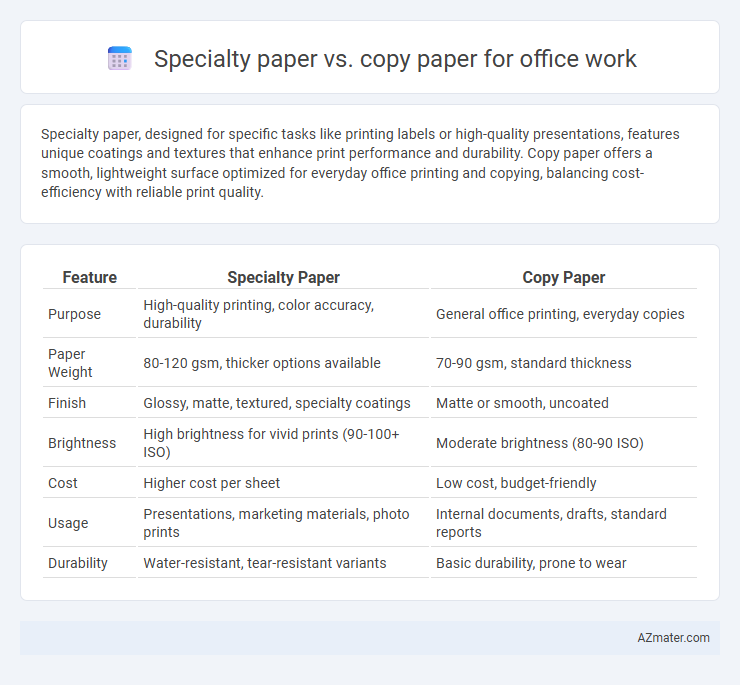Specialty paper, designed for specific tasks like printing labels or high-quality presentations, features unique coatings and textures that enhance print performance and durability. Copy paper offers a smooth, lightweight surface optimized for everyday office printing and copying, balancing cost-efficiency with reliable print quality.
Table of Comparison
| Feature | Specialty Paper | Copy Paper |
|---|---|---|
| Purpose | High-quality printing, color accuracy, durability | General office printing, everyday copies |
| Paper Weight | 80-120 gsm, thicker options available | 70-90 gsm, standard thickness |
| Finish | Glossy, matte, textured, specialty coatings | Matte or smooth, uncoated |
| Brightness | High brightness for vivid prints (90-100+ ISO) | Moderate brightness (80-90 ISO) |
| Cost | Higher cost per sheet | Low cost, budget-friendly |
| Usage | Presentations, marketing materials, photo prints | Internal documents, drafts, standard reports |
| Durability | Water-resistant, tear-resistant variants | Basic durability, prone to wear |
Understanding Specialty Paper and Copy Paper
Specialty paper, designed for specific printing needs, offers unique textures, weights, and finishes, enhancing visual appeal and durability for presentations, brochures, or labels. Copy paper serves as a cost-effective, versatile option primarily for everyday printing and copying tasks, typically featuring standard weight and brightness for clear, crisp text. Understanding these differences ensures selecting the right paper type optimizes output quality and supports the intended office workflow efficiently.
Key Differences Between Specialty and Copy Paper
Specialty paper is designed for specific tasks such as photo printing, labels, or cardstock, offering higher quality, unique textures, and enhanced durability compared to copy paper. Copy paper, typically used for everyday printing and copying, is lightweight, cost-effective, and optimized for fast ink absorption with consistent results on standard printers. The key differences lie in paper weight, finish, brightness, and purpose, with specialty paper providing superior print quality and copy paper focusing on efficiency and economy.
Applications of Specialty Paper in the Office
Specialty paper in office work is utilized for tasks requiring enhanced durability, texture, or visual impact, such as certificates, presentations, and official documents. It supports applications like branded letterheads, business cards, and promotional materials where paper quality influences professional appearance. Unlike standard copy paper, specialty paper accommodates processes like embossing, watermarking, and thermal printing, making it essential for high-quality, customized office outputs.
Common Uses of Copy Paper in Work Environments
Copy paper is extensively used in work environments for printing documents, reports, and memos due to its affordability and compatibility with standard office printers and copiers. It is ideal for routine assignments, drafts, and everyday communication materials where high-quality presentation is not a priority. Unlike specialty paper, copy paper provides a versatile and cost-effective solution for high-volume printing demands common in office settings.
Quality and Durability Comparison
Specialty paper offers higher quality with smoother texture, brighter whiteness, and enhanced opacity, making it ideal for professional presentations and important documents. Copy paper, while cost-effective and adequate for everyday printing tasks, typically has lower durability and may cause ink bleeding or paper jams in high-volume office printers. Choosing specialty paper ensures improved print clarity and longer-lasting documents, whereas copy paper suits standard office operations where durability is less critical.
Print Results: Specialty vs Copy Paper
Specialty paper offers enhanced print results with higher color vibrancy, sharper image quality, and better ink absorption compared to standard copy paper, making it ideal for presentations and marketing materials. Copy paper provides reliable, cost-effective performance for everyday office printing tasks, but may produce duller colors and less crisp prints. Selecting specialty paper optimizes the visual impact of printed documents, while copy paper supports volume efficiency.
Cost Implications for Businesses
Specialty paper, designed for specific tasks like presentations or high-quality printing, generally incurs higher costs compared to standard copy paper used for everyday office printing and copying. Businesses aiming to minimize expenses should consider the frequent use of cost-effective copy paper, which delivers adequate performance for routine documents without compromising budget. Investing in specialty paper is justified primarily for client-facing materials where enhanced print quality adds value, but overuse can significantly inflate office supply costs.
Environmental Impact and Sustainability
Specialty paper often incorporates recycled fibers and eco-friendly coatings, reducing environmental impact compared to conventional copy paper, which typically relies on virgin pulp and chemical bleaching. Producing specialty paper consumes less water and energy, contributing to greater sustainability in office use. Using specialty paper supports corporate green initiatives by minimizing waste and lowering carbon emissions throughout the paper's lifecycle.
Choosing the Right Paper for Office Needs
Specialty paper offers unique textures, weights, and finishes designed for specific office tasks like presentations, certificates, or marketing materials, enhancing professionalism and visual appeal. Copy paper, typically lightweight and smooth, is ideal for everyday printing, faxing, and photocopying, balancing cost-effectiveness with functionality. Choosing the right paper depends on the intended use, print quality requirements, and budget constraints to optimize office productivity and output quality.
Tips for Efficient Paper Management in Offices
Specialty paper, designed for specific tasks like presentations, brochures, or labels, differs significantly from copy paper, which serves everyday printing and photocopying needs. Efficient paper management in offices involves sorting documents by paper type to prevent jams and ensure printer compatibility, as well as adopting a centralized storage system to reduce clutter and improve accessibility. Regular inventory checks and prioritizing bulk purchases of standard copy paper can also streamline workflows and reduce overall costs.

Infographic: Specialty paper vs Copy paper for Office work
 azmater.com
azmater.com